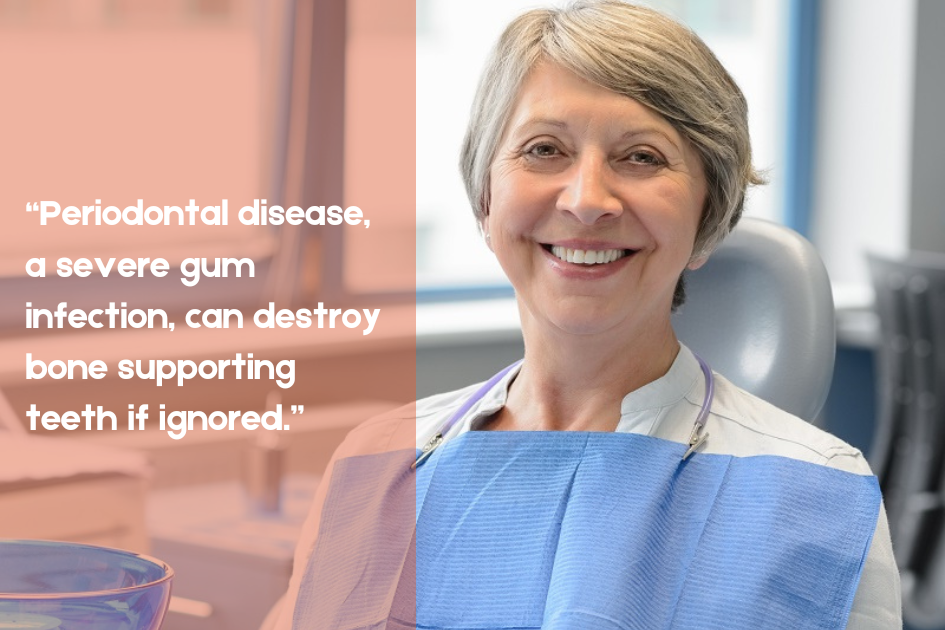‘A stitch in time saves nine’ – this adage is particularly relevant for periodontal disease. The purpose of this article is to provide you with information on this prevalent dental health problem and the crucial role Scaling and Root Planing plays in its control.
We aim to impart an understanding of this procedure, its advantages, and guidelines for aftercare, all with the goal of promoting a knowledgeable strategy for optimal dental health.
What is Periodontal Disease
Comprehending periodontal disease requires knowledge of it being a severe gum infection that harms the soft tissue and can, if ignored, annihilate the bone supporting your teeth. This condition gradually develops, often starting from gingivitis, a less severe gum disease, which could escalate to periodontitis without appropriate management.
Dental plaque, a sticky bacterial film that consistently forms on our teeth, is the primary offender behind periodontal disease. If not removed efficiently through habitual brushing and flossing, this plaque may solidify into tartar, leading to gum inflammation and bleeding – the preliminary indications of periodontal disease.
Elements that increase the risk of periodontal disease encompass inadequate oral hygiene, smoking, diabetes, genetic vulnerability, certain medications, and hormonal fluctuations in women. If identified at an early stage, periodontal disease can be reversed using professional treatment and commendable oral care at home. Nonetheless, during its severe stages, it could result in loss of teeth and has connections with other systemic diseases such as heart disease and diabetes.
Hence, it is of utmost significance that frequent dental examinations are upheld to observe gum health and to commence treatment swiftly if periodontal disease is observed.
The Consequences of Untreated Periodontal Disease
Ignoring periodontal disease can result in grave health consequences, encompassing both oral and systemic issues. At the onset, untreated gum afflictions may lead to gingivitis, signaled by symptoms such as inflamed, sensitive gums that bleed with ease. The disease’s advancement can result in periodontitis, a harsher form of gum disease, marked by receding gums, loose teeth, and persistent foul breath.
Also, unresolved periodontal disease brings systemic health dangers. Studies establish a connection between chronic inflammation from periodontitis and other grave conditions, including heart disease, diabetes, and respiratory illnesses. Pregnant women suffering from periodontal disease bear a heightened risk of delivering preterm or underweight infants.
The harm to the oral tissues and bone that support the teeth can ultimately result in tooth loss. This not only hinders the individual’s capacity to chew and converse effectively but also bears an impact on their self-confidence and life quality. The expense involved in treating advanced periodontal disease and replacing missing teeth can be hefty.
Hence, it becomes vital to pursue early treatment for periodontal disease. Techniques such as scaling and root planing can markedly slow down the disease’s progression, warding off further oral and systemic health issues.
Introduction to Scaling and Root Planing
Periodontal disease treatment primarily involves non-surgical procedures known as scaling and root planing. Their main function is to control the spread of the disease and enhance oral health. Often termed deep cleaning, these procedures focus on eliminating harmful bacteria and toxins found deep within the gum line.
In the context of oral hygiene, scaling refers to the elimination of plaque and tartar from all surfaces of the teeth. This goes beyond routine prophylaxis to combat gum inflammation and periodontitis. Specialized instruments are employed to remove deposits from the visible tooth area and the hidden parts beneath the gum line.
Conversely, root planing involves smoothing out rough spots on tooth roots. This action deters the accumulation of more plaque and tartar, promoting gum reattachment to the teeth. Post-procedure, antibiotics might be administered to the treated location to aid healing and ward off infection.
For patients showing early signs of periodontal disease, scaling and root planing are vital. They have the potential to reverse gum inflammation and halt further damage. The effectiveness of these procedures largely hinges on the patient’s dedication to maintaining good oral hygiene after the treatment.
The Scaling Process
During treatment for periodontal disease, the task of scaling holds significant weight. It involves a meticulous eradication of plaque and tartar from all tooth surfaces, moving beyond the range of typical cleanings. Specialized dental instruments are utilized in this deep-cleaning procedure, designed to reach tooth areas below the gum line. These tools specifically target the hard tartar deposits that standard tooth brushing cannot eliminate.
The process of scaling is usually divided into quadrants, treating distinct sections of the mouth sequentially to guarantee thorough cleaning and patient comfort. Depending on the intensity of plaque and tartar build-up, the dentist or dental hygienist may opt for a manual scaler or an ultrasonic device. The latter emits high-frequency vibrations to disintegrate hardened tartar, while simultaneously washing the area with water to clear the debris.
It’s crucial to understand that scaling, despite its effectiveness in plaque and tartar removal, does not tackle the problem of deep periodontal pockets that could develop due to severe gum disease. This is where root planing becomes relevant, serving as the subsequent phase in exhaustive periodontal care.
Diving Deeper into Root Planing
An in-depth examination of Root Planing reveals that it is an essential part of periodontal treatment. Root planing is the process through which tooth roots are smoothened out to eliminate bacterial toxins. This meticulous process primarily targets the rough areas on the root surface, home to disease-causing bacteria. It is a non-surgical treatment, often done under local anesthesia for the ease of the patient.
The technique involves the use of fine dental instruments to clean the root surfaces delicately. The primary aim is to get rid of dental plaque and calculus, which are breeding grounds for bacteria. Smoothing out the rough areas curbs bacteria from re-attaching, aiding healing, and acting as a deterrent to further tooth and bone loss.
After the procedure, patients may feel slight discomfort, which usually fades in a few days. Sustaining good oral hygiene post-procedure is vital to avert the return of periodontal disease. Regular dental check-ups also play a crucial role in tracking progress and ensuring the disease does not reappear.
Benefits of Scaling and Root Planing
Dr. Hoffman’s method for addressing periodontal disease through scaling and root planing yields a multitude of patient advantages. This process is non-invasive and offers instantaneous relief from gum disease discomfort. It also enhances oral health, ultimately improving patients’ overall life quality.
The advantages of scaling and root planing fall under three primary categories:
– Stops the progression of the disease by eliminating plaque and tartar
– Decreases gum inflammation which results in diminished bleeding and swelling
– Aids in preventing tooth loss, bolstering enduring dental health
– Purifies and smoothens tooth surfaces, improving their look
– Removes bad breath induced by bacterial accumulation
– Boosts the health and appearance of the gum line
– Lowers the chance of secondary health issues associated with gum disease, such as heart disease or diabetes
– Promotes more straightforward dental cleaning and upkeep
– Fosters healthier oral habits
Dr. Hoffman’s comprehensive method to gum disease treatment ensures patients are offered the best possible standard of care. Scaling and root planing is a crucial element of this all-encompassing method, providing distinct health, visual, and preventive advantages.
Post-Procedure Care and Maintenance
After the beneficial scaling and root planing procedure, focusing on the care and maintenance following it is crucial for upholding the benefits of the treatment. This includes habitual dental cleaning practices complemented by specific steps to manage infection and promote healing.
Patients need to brush and floss with care yet effectively to maintain cleanliness without disturbing the treated areas. A dentist might suggest an antimicrobial mouthwash to curb bacterial growth. Any discomfort or sensitivity can be controlled using available medications or a prescribed one if required.
Eating healthily aids in recovery. Consuming soft, non-irritating foods is suggested for several days after the procedure. Smoking and alcohol are to be avoided, given their potential to hinder healing and worsen periodontal problems.
Periodic appointments with your dentist are vital for tracking healing and clearing any leftover plaque or tartar. These sessions allow the dentist to modify your oral hygiene routine if required.
Over the long haul, preserving a steady oral care routine at home, along with professional cleanings and check-ups, is pivotal in avoiding a relapse of periodontal disease and keeping your teeth and gums healthy.
When is Scaling and Root Planing Recommended
Scaling and root planing, a standard treatment for periodontal disease, is particularly suggested when the illness has progressed past the initial phase of gingivitis, leading to the creation of deep gaps between gums and teeth. These cavities are susceptible to bacterial infections, which may result in inflammation of the gums and ongoing degradation of the periodontal ligaments and bone.
Progressed Periodontal Disease
- Formation of deep gaps
- Inflamed gums
- Damage to periodontal ligament and bone
The need for scaling and root planing becomes apparent when routine cleaning fails to entirely eliminate plaque and tartar. This procedure effectively eradicates bacteria and smoothens root surfaces, thus acting as a barrier against future plaque and tartar accumulation.
Inadequacy of Routine Cleaning
- Failure to eradicate deeply embedded plaque and tartar
- Requirement for professional periodontal cleaning
The suggestion for scaling and root planing also arises when the patient exhibits symptoms that include constant foul breath, inflamed or red gums, gum bleeding during brushing, or wobbly teeth.
Signs Indicating the Need for Scaling and Root Planing
- Constant foul breath
- Inflamed or red gums
- Bleeding during brushing
- Wobbly teeth
These symptoms serve as undeniable evidence that periodontal disease has advanced considerably, making the treatment of scaling and root planing a necessity.
Alternatives and Additional Treatments
Beyond scaling and root planing, there exist treatments capable of tackling advanced periodontal disease. Such methods are tailored to different stages of the disease and are selected based on the patient’s distinct requirements.
Dental implants represent one such treatment. Often suggested when disease progression has resulted in tooth loss, these synthetic tooth roots are embedded into the jawbone, replacing missing teeth and reinstating functionality and aesthetics.
Tissue regeneration serves as an alternate solution. When periodontal disease has inflicted severe damage on gum tissue and bone, regeneration techniques can trigger the body’s innate ability to replenish these lost tissues and bone. Such procedures commonly involve the positioning of a regenerative substance, such as a membrane, graft tissue, or tissue-stimulating protein, where bone loss has occurred to promote healing.
For more severe instances, pocket elimination surgery could be required. This surgical method minimizes the depth of the gum pockets, simplifying the cleaning and upkeep of the area, and halting the disease’s further progression.
Conclusion
Periodontal disease is a serious oral health issue that can have severe consequences if left untreated. However, with procedures such as Scaling and Root Planing, it can be managed effectively.
Why not take the first step towards a healthier mouth today by considering this non-surgical option?
Don’t forget, regular dental exams and cleanings are key to prevention and early detection. Equip yourself with the knowledge and power to maintain optimal oral health.
So, don’t wait! Schedule your dental check-up with Family Dental of Teravista, Georgetown, TX now and ensure a healthier, happier smile.














